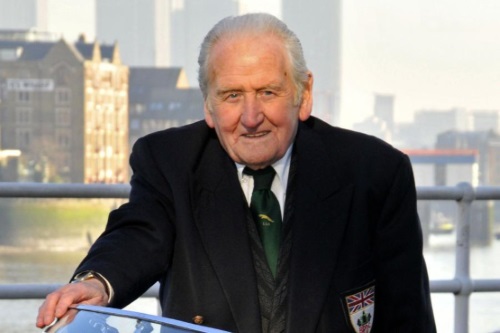
The BRDC joins the motor racing world in mourning the passing last Saturday of Honorary Member Norman Dewis, one of the outstanding personalities of the British motor industry since World War 2. He was 98 and had hoped to be able to celebrate reaching his personal ‘ton’ by driving a Jaguar at 100 mph but it wasn’t to be.
Although most associated with Jaguar, Norman first joined Humber on leaving school at the age of 14 from where he moved to an apprenticeship at Armstrong-Siddeley. When war intervened, Norman joined the RAF as an air gunner on the ponderous Bristol Blenheims until ill health precluded him from further flying after 1942. For the remainder of the War Norman worked for the Aeronautical Inspection Directorate of the Air Ministry in the course of which he came into contact with Lea-Francis for whom he went to work at the cessation of hostilities. By 1947 he had become chief test engineer for Lea-Francis and was soon filling his spare time by designing and building a racing car for the burgeoning 500 cc category. Together with fellow Lea-Francis employee Peter North-Coates, the DNC was built to a very high standard but it was powered by an elderly Rudge motor cycle engine which expired in the car’s first race, at Silverstone in July 1950. Norman rebuilt the engine and raced the DNC a few more times at Silverstone and other ex-airfield circuits such as Gamston and Turnberry.
In 1952 Norman moved to Jaguar as chief test development engineer, remaining with the company for the rest of his working life and beyond. The ‘50s were the days of Jaguar’s emergence as one of the leading sports car manufacturers in the world, enhancing its road cars’ reputations with success on the track, in particular in the Le Mans 24 Hours. Norman was responsible to Jaguar’s chief engineer Bill Heynes for the development of the succession of great cars to emerge from the Jaguar production lines including the C-type and D-type sports-racing cars, the E-type which became a legend from the day of its launch in March 1961, and the Mk 1 and Mk 2 2.4, 3.4 and 3.8 saloons. Although the XK120 had preceded Norman’s arrival at Jaguar, he was at the helm of the specially developed version which set new speed records at over 172 mph on the Jabbeke autoroute in Belgium in October 1953, an achievement commemorated 50 years later by the unveiling of a plaque in the town centre.
Norman was also heavily involved in the development with Dunlop of the disc brake, a feature taken for granted today but not without its teething troubles in the early ‘50s. Perhaps the ultimate test came in the 1952 Mille Miglia when Norman agreed to sit alongside Stirling Moss throughout the race round northern and central Italy in a Jaguar C-type. They were in third place with about 150 of the 1000 miles remaining, when the steering collapsed.
Norman was considered too valuable by Sir William Lyons to be permitted to race although he was regularly entered as reserve driver for the factory cars. This led to him driving in the 1955 Le Mans 24 Hours after two of the original drivers, Jimmy Stewart and Desmond Titterington, had to withdraw following accidents in the Nurburgring 1000 Ks. Norman was paired with Don Beauman; while waiting on the pit counter to take over,he witnessed the dreadful accident involving the Mercedes-Benz 300SLR of Pierre ‘Levegh’ and Lance Macklin’s Austin-Healey 100S which resulted in the deaths of over 80 spectators. After completing an extended stint in the D-type (XKD508), Norman handed the car back to Don Beauman who went into a sandbank at Arnage from which he was unable to extricate the car. They had been running in fourth place at the time. Norman did have the chance to race a D-type (XKC003) once more, in the Goodwood 9 Hours when he shared Jack Broadhead’s to fifth place with Bob Berry.
Norman remained with Jaguar, testing and developing all the new models including the never-to-be raced XJ13. He endured the unpalatable years of British Leyland ownership before retiring in 1985. His role in the history of Jaguar was never forgotten by the many enthusiasts of the marque around the world and he was constantly in demand for Jaguar events of all kinds where, proudly wearing a large BRDC badge, his remarkable memory and way with words allowed later generations to understand and appreciate how Jaguar rose to become one of the world’s greatest motor manufacturers. In 2015 he was awarded the OBE for services to the British motor industry. The BRDC extends its deepest condolences to Norman’s son Graeme and daughter Linda and many friends around the world. A private funeral service for family and friends will be held for Norman in the coming weeks and a memorial service is likely to be arranged later in the year. Details will be shared with Members once they are known.
